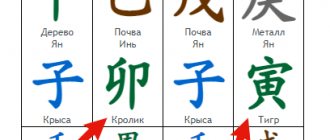Professions and activities based on the 5 elements (ba-tzu)
Dear colleagues! I would like to note that the opinions of different masters regarding the belonging of professions to one or another element in the ba zi chart , namely: Water, Wood, Fire, Earth and Metal , often do not agree. I tried to analyze this issue as much as possible and bring to your attention a simple method for determining whether professions belong to elemental elements . Of course, I cannot include all existing professions and specialties in this review. But if you have any questions, I will be happy to answer them. So...Have you ever asked yourself the following questions: “Did I choose my profession ? Does it bring me moral satisfaction and good income? If such questions arise, most likely your profession or field of activity does not suit you in elements. If work as an element is not favorable for you, you will never earn much. There are good periods in the life of any person, but they pass, and again everything becomes the way it was, unfortunately. about choosing a profession according to Ba Zi is that it not only helps you find a suitable profession that will bring you a good income. By doing your own thing, something that is beneficial for yourself, you can still correct an unfavorable period in your life and maintain your health. Let's try to sort out this difficult issue. Important! When determining a profession and type of activity: - it is necessary to determine the main (leading) element of the personality - this is the goal of the activity; - it is necessary to determine the auxiliary elements - these are materials and tools, as well as the place and style of work. The purpose of the activity prevails over tools and materials. It’s difficult to say in percentage terms, about 70/30% approximately, but not 50/50%, that’s for sure. The basic rules for determining which element a particular activity or specialty belongs to (also applies to additional work/earnings and hobbies) are as follows: 1. It is necessary to determine what the person is in contact with. If the profession is working, then according to the material that is processed by a person. Let's say, when a person deals with metal parts or tools, if he is a car mechanic, for example, then such a person deals with the Metal , and if a person is a mason and builds brickwork, then with the Earth element. However, if a person is a crane operator or excavator operator by profession, then he works in Metal , but on Earth. What is the leading element in this case? Metal? But no. Earth, because these specialties are applicable exclusively in construction - buildings, structures, roads, bridges, and any construction is the Earth. It’s even more difficult with welders: they work where - in construction, i.e. on Earth, works with something – Metal, works with something – Fire. All of the listed specialists are first and foremost builders, and their leading element is the Earth, and only then are they crane operators, welders, masons, etc. I hope the principle is clear. In other words, we must not lose sight of the fact that at present the interpenetration of different elements in modern specialties and activities is a fairly common phenomenon.
2. Consideration should be given to where the person works. If a person, for example, is a lawyer (or more correctly, a legal consultant), and jurisprudence is always Metal, but he does not work in the field of criminal law (which is also Metal), but in companies operating in other areas, then our lawyer adds to himself auxiliary element: - Land, if he works in a construction company or in the field of land law; — Water, if he works in medicine, in the service sector or in the field of water law; - Wood - in agriculture, textile production, etc., - Fire - in energy, chemical industry, etc.
3. It is necessary to analyze the profession or specialty into its components in more detail. For example, some masters classify most engineering and technical specialties as Metal, but this is far from true. After all, electricity and energy are Fire. It is interesting that computers, tablets, smartphones and other gadgets also belong to Fire, and information technology as the transfer of information, as well as software, should be classified as Water. Here you can return to paragraphs. 1 and 2, and carry out a similar analysis. Who, what, on what and where our engineer works. Since we started with construction, let’s continue and look at the example of a civil engineer (let him be a designer). In any case, the leading element of his specialty is the Earth. If he works in a design institute or company whose main activity is the design of buildings and structures, this is again the Earth. If our designer is mainly involved in calculations and design of reinforced concrete structures, this is again Earth, and if metal or wooden structures are involved, Metal and Wood, respectively (but these factors add the corresponding elements no longer significantly). If an engineer draws or calculates on a computer, he adds Fire, if manually on paper, he adds Wood (these factors are also not so significant). And if the designer works in the design department of a metal structures plant, then the percentage of additional Metal will be higher.
Let's look at medicine. Some masters believe that medicine is Wood and Water, because Wood is associated with health and a patient attitude towards other people, and Water is the flow of life. I am among those who believe that in the medical profession the leading element is only Water. But medicine and medical practice always consists of several elements (at least two), depending on the direction. An additional element is: in cardiology - Fire (since the circulatory system and the heart belong to Fire), in surgery, orthopedics and dentistry - Metal, in homeopathy, naturopathy, rehabilitation, alternative medicine - Wood, in endocrinology - Earth. And if the surgeon, for example, is a military man, then this is already twice Metal, and it becomes very significant. There is an opinion that Eastern medicine is Wood, and Western medicine is Metal, which is completely wrong, this is too narrow a view.
4. You should definitely take into account exactly how you are busy at work, what your position and job responsibilities are, and what your working style is. This is an opportunity for correction, even if you cannot or do not want to change your profession, the work suits you, but you would like to make it more profitable. For example, if you need Water, but the element of your profession is different, you can at least get a job where you will need to go on business trips more often or communicate more, work with clients, partners, etc., and such activity will already correspond to the expressed energy Water. If you manage a team or consult, add Metal to yourself. Metal is associated with precise planning and punctuality. Land is associated with the preservation of values, stability, immobility. To add Earth, you need to become more diligent, immobile, choose a style of work so that you don’t run around the office or enterprise yourself, but so that people come to your office. Don’t go to clients’ homes, but have them come to your work or office. Fire is associated with activity, the ability to “light up” others, arouse in them enthusiasm and interest in work, and lead them. And finally, if you start offering interesting creative solutions and ideas (at absolutely any job), you will add the Wood element to yourself. Of course, this way you won’t be able to add a large percentage of the required element, but it’s still better than nothing.
5. And one more thing. If there is absolutely no opportunity or desire to change your main job, you can find an additional one, or start a hobby in your useful element.
Approximate list of professions and areas of activity by element:
Wood - growth and development, an element that creates new things: Joiners, carpenters, wood carvers, wood sculptors Paper production Construction of wooden houses (+ Earth leading) Nannies and teachers of kindergartens, nurseries, tutors Any child care institutions Doctors of oriental medicine, homeopaths, naturopaths (+ Leading water) Massage therapists Pharmaceuticals - production of herbal preparations Any design Architecture (unique projects) Drawing Cooking, canteens, cafes (non-alcoholic) Cook, confectioner (+ Additional land) Physical education workers (not professional sports) Fitness Hairdressers Plant growing, landscape design , floristry Agronomists Nutrition and dietetics Weaving (especially natural fabrics) and textile industry Casual fashion, clothing production Writers, poets Translation, creative writing, journalism (article writing) Butchers Huntsmen
Fire - expansion of consciousness, nature of transformation, chemical reactions: Church, religion Chemical industry Pharmaceuticals - production of drugs of non-plant origin Plastic production Oratory Professional sports Any mental activity Circus Satire Educational activity Scientific research, any exact sciences Scientific journalism Cosmonautics, astronomy, space research Beauty salons High fashion (haute couture) Show business, organization of events Production of fireworks, explosives Welders Computer work, programming Finance Psychology Analytics of any kind Livestock (+ additional wood) Hunting Work with natural fur, leather, silk, wool Production of synthetic products Computer technology Solar energy Energy Oil and gas industry (+ Additional water) Exchange (+ Additional water) Meat industry
Earth - sustainability, stability, preservation and care: Vegetable growing, soil cultivation Real estate, realtors Construction Manufacturing of building materials Architecture, interior design (standard projects) Mining Miners, geologists, archaeologists, surveyors, reclamation surveyors Topographers (on the ground) Jewelers, craftsmen stone, stone sculptors Ceramics production Librarians (+ Leading tree) Hotel business Warehousing activities Pawn shops Confectionery production Road and municipal services
Metal - structuring and order: Army, military personnel Administrative and legal system Heads of enterprises (+ element of the enterprise's field of activity) Managers, managers, administrators Order takers Steelworkers, heavy industry, rolled metal Defense industry, aviation Metal jewelers, metal sculpture Hostess (reception service guests) Banking activities Human Resources departments Programmers (+ Fire leading), system administrator Electricians (+ Fire leading) Accounting, audit Tax service Social services (pension, children's + Wood) Financial markets, economists, statistics, reporting (+ Fire) Manufacturing of metal products , weapons, money Car service Politics Law enforcement agencies Official sphere, executive power Lawyers
Water - information, changes, adaptability, flows: Drinking restaurants, glass bars Discotheques Trade, purchase and sale Drivers, pilots (+ Metal) Firefighters Fishing and fish production Travel Theater, cinema, music Baths, laundries Hydrogeology, oceanology Marine and river business, shipping Treatment facilities Drinking water production Plumbers Construction and maintenance of hydroelectric power station fountains Transport flows, any transportation Cash flows, trade flows Information flows, journalism, media Internet, telephony, television, mail Logistics, couriers Logistics and technical supply Network marketing Gambling business Any professions related to communication Writing music, lyrics, romance novels Literary activity Tourism
To summarize, let us once again repeat the algorithm for determining the elements that a profession or field of activity contains : 1. Determine the leading element. 2. Determine additional elements, taking into account such circumstances as: - materials and equipment with which the person works; - the place where a person works. 3. Determine the person’s work style and, if necessary, adjust it.
That's all. Health, good luck and, of course, great success in your work!
Best regards, Earnwulf (c)
Blast furnace hearth
A modern furnace is a complex metallurgical unit several dozen floors high. The leading profession here is the blast furnace furnace. He is the first to take over the baton from iron ore miners in blast furnace production. It is his skill and experience that most often determine the successes or failures of a large team of blast furnace shop workers.
The miners work as part of a team whose main goal is to conduct the smelting process more economically and to release pig iron and slag from the blast furnace in a timely manner.
The requirements for people who want to master this profession are somewhat higher compared to other specialties. They must have good health and high reliability of work as part of the team, since
a single mistake can cost too much for all those who operate the blast furnace.
The work of the forges is dynamic in nature, since team members constantly move around the work site (along the perimeter of the blast furnace), monitoring the progress of the technological process for producing cast iron through special viewing eyes. This profession is subject only to people who are courageous, brave and reliable in their work.
Metallurgical engineer for blast furnace production
The merits of domestic scientists - blast furnace specialists in our country and abroad are great. Great demands are placed on the modern engineer. A person who has chosen the profession of a metallurgical engineer must first of all have a good knowledge of such disciplines as chemistry, physics, mathematics, and the basics of computer technology. This specialty can be obtained at metallurgical institutes, at metallurgical faculties of polytechnics or other institutes.
Future engineers study a large number of general scientific and special disciplines. In addition, at the institute, specialists in the field of design and operation of modern blast furnace production are given in-depth knowledge of the economics of metallurgical enterprises, the basics of pedagogy and the sociology of relationships between the workforce and the manager.
Metallurgical production crane operator
The owner of the workshop is called the crane operator in metallurgical workshops. The driver has a lot to worry about: he needs to deliver molds for casting the finished metal, move semi-finished products for processing, send a faulty part of the rolling mill for repair, and remove the unused electrolyzer anode.
In an iron production shop, a machinist uses a crane to do almost everything related to the smelting of iron: transports chutes for pouring iron, installs and extends the electrodes of an electric melting furnace, loads the charge into the furnace, replaces slag bowls and performs many other works. The work of a crane operator is not only distinguished by the ability to perform various tasks of lifting and transporting goods. A worker in this profession must have a good understanding of the structure of various types of cranes.
Transportation of goods is carried out over areas of the workshop where people work, and the work of the driver in these conditions imposes great responsibility on his activities.
A crane operator must have good vision, an accurate eye, excellent hearing and a stable vestibular system.
This profession is contraindicated for those who are afraid of heights and get lost in critical situations.
Smelter
Metals and alloys are melted by a skilled worker - a smelter. This profession is the main one in metallurgy. The smelter must know the chemical processes taking place in the furnaces during smelting and the requirements for them. The quality of the finished metal depends on all this.
The smelter is at the workplace during the entire metal melting process. First he prepares the smelting furnace for operation.
The melter must be aware of various parameters: for example, the moisture content of the filling mass and the speed of its release. The smelter also prepares ores and concentrates for smelting, for which he prepares various mixtures of materials (charge) in certain proportions for subsequent processing in furnaces.
After refueling and starting up the furnace, the smelter is the sole owner of the melting process until its completion.
Metal is poured into molds - molds - and transported for storage.
Strong, strong young people who love the element of fire and want to create products necessary for people are invited to take up this profession.
Cold metal rolling machine
Metal processing in a rolling mill is carried out by rotating rollers and rollers (hence the name of the professions), between which ingots are rolled under pressure.
A cold metal roller in non-ferrous metallurgy rolls titanium, tungsten, molybdenum and zirconium alloys, as well as various types of foil.
In accordance with the progress of the technological process, the rolling operator first prepares the mill for work for rolling metal of a certain profile. He does this as part of a metalworking and repair team.
The main types of work of a rolling operator: rolling foil, tapes, sheets and strips, controlling the operation of the mill, measuring and monitoring the profile of products, removing the roll after rolling, repairs.
A feeling of admiration for the work of a roller covers everyone who visits a rolling mill and watches the process of transforming a rough ingot, slowly floating along a roller table, into beautiful, elegant foil or tape. And this process is controlled by a highly qualified worker - a cold metal roller!
Technician – blast furnace production technologist
Technician - blast furnace production technologist, according to the level of qualification, belongs to the middle level of engineering and technical workers. They need not only technical knowledge, but also the ability to work individually with people, and to carry out the entire technological process with the help of technology in a cost-effective manner.
The mental activity of a blast furnace production technician is inextricably linked with his practical actions. In his work, he is always helped by such qualities as resourcefulness, quick wit, ingenuity, original and prompt solutions to constantly arising production problems during the shift. A feature of visual perception is the ability to determine the temperature of the metal by color, by the nature of the behavior of sparks (when releasing the melt) - the approximate chemical composition of cast iron, etc.
If we talk about other personality qualities that he needs, we note the following: endurance, patience, composure and efficiency, tact and self-control.
Where do they teach
The profession has the qualifications of a technician (secondary specialized education) and an engineer (higher education). Secondary specialized education can be obtained at all geological exploration colleges in the country, for example, at the St. Petersburg College of Geodesy and Cartography. (Kazanskaya St., 3. Tel. 444-24-78, 444-18-34)
The best higher educational institutions that train hydrogeologists: Specialty “Search and exploration of groundwater and engineering-geological surveys”. Moscow State University. Geological Faculty. Leninskie Gory, Tel. 939-29-51. Moscow State Geological Exploration Academy. Miklouho-Maclay St., 23. Tel. 433-55-77. Moscow State University of Environmental Management. St. Pryanishnikova, 19. Tel. 976-11-23, 976-14-36. Kazan (Volga Region) Federal University of Natural Sciences and Humanities, Republic of Tatarstan, Kazan. St. Petersburg State University. Universitetskaya embankment, 7/9. Tel.328-20-00. St. Petersburg State Mining Institute (Technical University). V.O., 21st line, Tel. 328-82-01, 321-40-81. North-Eastern Federal University named after M.K. Ammosova, Faculty of Natural Sciences and Humanities, Republic of Sakha (Yakutia), Yakutsk. Siberian Federal University of Natural Sciences and Humanities, Krasnoyarsk Territory, Krasnoyarsk. North Caucasus State Technical University, Stavropol Territory, Stavropol. Astrakhan State University of Natural Sciences and Humanities, Astrakhan Region, Astrakhan. Belgorod State University of Natural Sciences and Humanities, Belgorod region, Belgorod. Irkutsk State Technical University, Irkutsk region, Irkutsk. South Russian State Technical University (Novocherkassk Polytechnic Institute) Rostov region, Novocherkassk. Ural State Mining University, Sverdlovsk region, Yekaterinburg. National Research Tomsk Polytechnic University, Tomsk region, Tomsk. Tyumen State Oil and Gas University, Tyumen region, Tyumen. Chita State University of Natural Sciences and Humanities, Trans-Baikal Territory, Chita. Russian State Geological Prospecting University named after Sergo Ordzhonikidze, Moscow. St. Petersburg State Mining Institute named after G.V. Plekhanov, St. Petersburg. Grozny State Petroleum Institute named after Academician M.D. Millionshchikova, Chechen Republic, Grozny. Moscow State Open University, Moscow
Steel pourer
The steel pourer is, as it were, a co-author of the steelmaker in the steel making process. Molten liquid steel in a steel melting furnace is not yet a finished product. It is still necessary to ensure that during solidification, or crystallization, it takes the form of castings or ingots, which are suitable for further processing.
Casters must know the technological process of steel casting, the composition and properties of refractory materials used for the internal lining of steel-pouring ladles and for the manufacture of stoppers. They need to master the structure and operating principle of the locking mechanism, as well as the types of molds for various grades of steel smelted in the workshop. The work of a pourer is quite varied and requires proper planning and simultaneous consideration of various factors. Factors that influence the quality of steel casting are the grade and temperature of the steel being cast, the size of the ladle, molds, the configuration of the mold for shaped castings and some others.
The profession of a steel pourer requires consistency, determination, efficiency, but not fussiness. He must have a steady hand and an accurate eye.
Hot metal roller
Unlike a roller, a roller works with hot metal, which is heated in ring furnaces with a system for loading and unloading ingots. The distributor sets the furnace mode, maintains and controls it. After heating, the metal is delivered to the rollers of the rolling mill using a roller conveyor.
Professional knowledge, skills and abilities necessary to work as a hot metal roller are formed in vocational schools and reinforced in practice in the workshops of the base enterprise. In addition to his main profession, the rolling operator has the skills and abilities of a 2nd category repairman, since he has to participate in the work of the team for the installation, dismantling and repair of not only the rolling mill, but also other auxiliary mechanisms. Some of the work is done manually using metalworking tools. And here, excellent physical training will also be of great help to the rolling worker.
Many difficulties await those who choose this profession. But everything is redeemed by a feeling of satisfaction if the choice turned out to be a genuine recognition











